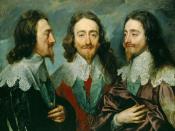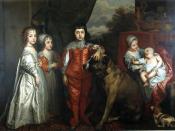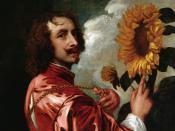Baroque art emerged in Europe in the seventeenth century as a reaction against the intricate and standard Mannerist style which dominated the Late Renaissance. Baroque art is less complex, more realistic, and more emotionally affecting than Mannerism. Among the many artists who flourished in the Baroque era, Anthony van Dyck had an illustrious, independent career as a portraitist and later became the leading court painter in England (Stokstad).
Van Dyck was born, the son of a rich silk merchant, on March 22, 1599 in Antwerp, Belgium. His bright artistic talent was already obvious at age eleven when he was apprenticed to the historical Flemish painter Hendrik van Balen. In 1618, just before his nineteenth birthday, he was admitted to the Antwerp guild of painters. He spent the next two years as a member of the workshop of the Flemish painter Peter Paul Rubens (Lawson).
From 1620 to 1625, van Dyck traveled in Italy where he was in great demand as a portraitist, and he developed his maturing style.
He toned down the Flemish influence of his early work to concentrate on a more dignified, elegant manner. In his portraits of Italian aristocrats, he created idealized figures with proud stances, slender figures, and the famous expressive "van Dyck" hands. Influenced by the great Venetian painters Titian, Paolo Veronese, and Giovanni Bellini, he adopted colors of great richness and jewel-like purity. No other painter of the age surpassed van Dyck at portraying the shimmering whites of satin, the smooth blues of silk, or the rich crimsons of velvet. He was the ideal painter of aristocracy and showed himself capable of creating brilliantly accurate likenesses of his subjects, while he also developed a repertoire of portrait types that served him well in his later work at the court of Charles I of England...


